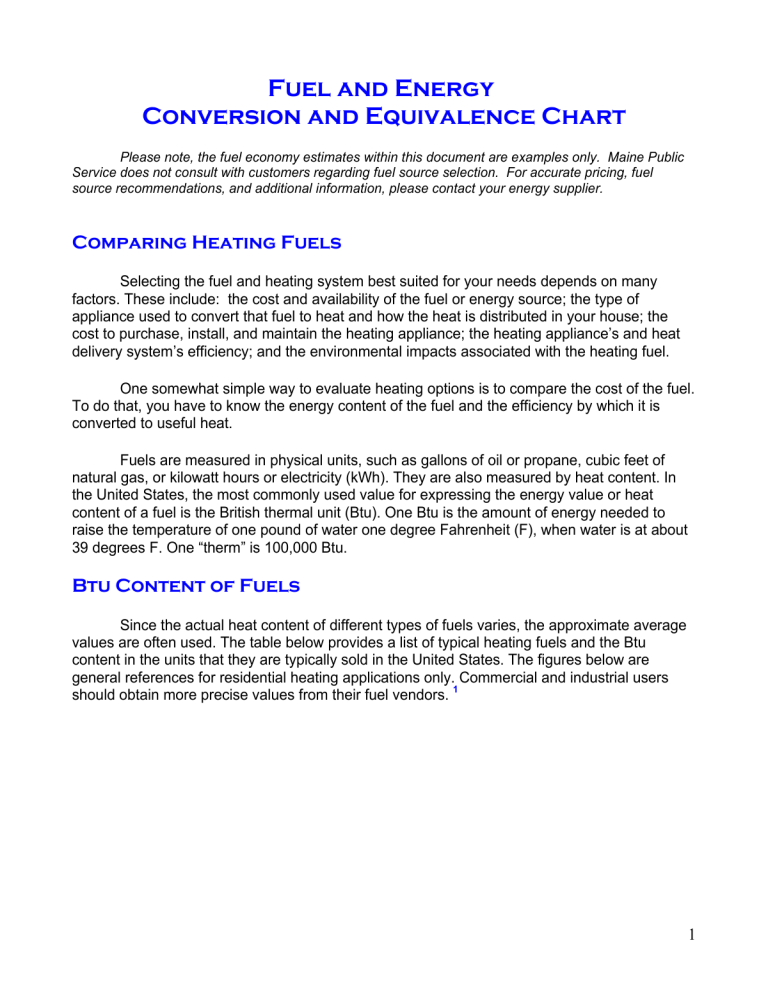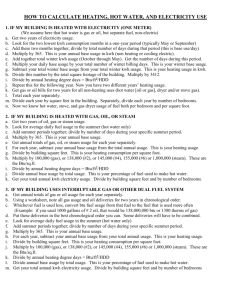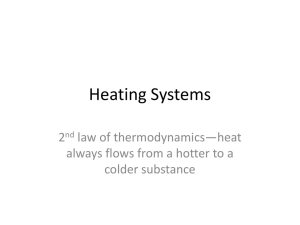Fuel and Energy Conversion and Equivalence Chart

Fuel and Energy
Conversion and Equivalence Chart
Please note, the fuel economy estimates within this document are examples only. Maine Public
Service does not consult with customers regarding fuel source selection. For accurate pricing, fuel source recommendations, and additional information, please contact your energy supplier.
Comparing Heating Fuels
Selecting the fuel and heating system best suited for your needs depends on many factors. These include: the cost and availability of the fuel or energy source; the type of appliance used to convert that fuel to heat and how the heat is distributed in your house; the cost to purchase, install, and maintain the heating appliance; the heating appliance’s and heat delivery system’s efficiency; and the environmental impacts associated with the heating fuel.
One somewhat simple way to evaluate heating options is to compare the cost of the fuel.
To do that, you have to know the energy content of the fuel and the efficiency by which it is converted to useful heat.
Fuels are measured in physical units, such as gallons of oil or propane, cubic feet of natural gas, or kilowatt hours or electricity (kWh). They are also measured by heat content. In the United States, the most commonly used value for expressing the energy value or heat content of a fuel is the British thermal unit (Btu). One Btu is the amount of energy needed to raise the temperature of one pound of water one degree Fahrenheit (F), when water is at about
39 degrees F. One “therm” is 100,000 Btu.
Btu Content of Fuels
Since the actual heat content of different types of fuels varies, the approximate average values are often used. The table below provides a list of typical heating fuels and the Btu content in the units that they are typically sold in the United States. The figures below are general references for residential heating applications only. Commercial and industrial users should obtain more precise values from their fuel vendors.
1
1
Table 1 – Average Btu Content of Fuels
Electricity:
1 KW 3,412 Btu/hr
Natural Gas:
1 Cubic Foot of Natural Gas
1 CCF = 100 Cu Ft = 1 Therm
1,030 Btu’s
103,000 Btu’s
1 MCF = 1,000 Cu Ft = 10 Therms 1,034,000 Btu’s = 1.034 MMBtu’s
Propane:
1 Gal Propane
1 Cu Ft Propane
Gasoline:
91,600 Btu’s
2,500 Btu’s
1 Gal of Gasoline (mid grade)
Ethanol:
1 Gal of Ethanol
Fuel Oil:
1 Gal of #1 Kerosene
1 Gal of #2 Fuel Oil
1 Gal of #4 Fuel Oil
1 Gal of #6 Fuel Oil
125,000 Btu’s
76,000 Btu’s
135,000 Btu’s
138,000 Btu’s
145,000 Btu’s
150,000 Btu’s
Other:
Wood (air dried) 20,000,000/cord or 8,000/pound
Pellets (for pellet stoves; premium) 16,500,000/ton
Coal 28,000,000/ton
1 Barrel of Oil =
1 Btu =
1 Btu =
1 ton of refrigeration =
42 Gallons
252 calories
.293 watt
12,000 Btu/hr
1lb residential garbage = 2,500 Btu
1lb coal = 12,000 Btu
1lb wood =
1hp =
3,500 Btu
746 watts
1hp =
1hp =
1hp =
1 watt =
1 kilowatt =
1 kilowatt =
1,000 kilowatts =
33,479 Btu/hr (boiler)
33,000 foot-lbs./min
42,440 Btu/min.
3.412 Btu
1,000 watts
1.341 horsepower
1 Megawatt
2
All of the following fuels are equivalent to 1,000,000 Btu’s.
Electricity Natural Gas:
293.083 kWh
(3,412 Btu/kWh)
1 MCF, 10 therms or 1,000 cubic feet
Coal: Propane
83.34 pounds
@ 12,000 Btu/pound
10.917 gallons
@ 91,000 Btu/gallon
Gasoline Fuel Oil #2
8.0 gallons
@125,000 Btu/gallon
7.194 gallons
@ 139,000 Btu/gallon
Fuel Oil
#6
6.67 gallons
@ 150,000 Btu/gallon
Wood
285.7 pounds
@ 3,500 Btu/pound
2
These standards of measurement make comparisons of fuel types possible. For example:
• The heat content of one gallon of fuel oil roughly equals that of 41 kWh of electricity,
137 cubic feet of natural gas, 1.5 gallons of propane, 17.5 pounds of air-dried wood,
17 pounds of pellets, a gallon of kerosene, or 10 pounds of coal.
• One million Btu’s is the heat equivalent of approximately 7 gallons of No. 2 heating oil or kerosene, 293 kWh of electricity, 976 cubic feet of natural gas, 11 gallons of propane,
125 pounds of air-dried wood, 121 pounds of pellets, or 71 pounds of coal.
•
The efficiency of the heating appliance is an important factor when determining the cost of a given amount of heat. In general, the efficiency is determined by measuring how well an appliance turns fuel into useful heat. (The condition of the heat distribution or delivery system also affects the overall system efficiency.) Many types of space heating appliances must meet minimum standards for efficiency developed by the U.S.
Department of Energy. Table 2 provides average efficiencies for common heating appliances.
3
Table 2: Estimated Average Fuel Conversion Efficiency of Common Heating Appliances
Fuel Type - Heating Equipment
Coal (bituminous)
Efficiency (%)
Central heating, hand-fired
Central heating, stoker-fired
Water heating, pot stove (50 gal.)
Oil
45.0
60.0
14.5
High efficiency central heating
Typical central heating
Water heater (50 gal.)
Gas Propane
High efficiency central furnace
Typical central boiler
Minimum efficiency central furnace
Room heater, unvented
Room heater, vented
Water heater (50 gal.)
Electricity
Baseboard, resistance
Central heating, forced air
Central heating, heat pump
Ground source heat pump
Water heaters (50 gal.)
Wood and Pellets
Stoves with circulating fans
Catalytic stoves
Pellet stoves
89.0
80.0
59.5
80.0
97.0
85.0
78.0
99.0
65.0
62.0
99.0
97.0
200+
300+
97.0
40.0 - 70.0
65.0 - 75.0
85.0 - 90.0
Wood heating values can vary significantly. The most important factor affecting useful
Btu content is the moisture content of the wood. Well-seasoned, air-dried wood will typically have a moisture content of around 20 percent (when compared to a “bone dry” sample of the wood). A very rough approximation of the effect of moisture content on the heating value is for every percent increase in moisture content (relative to a bone-dry sample) there is a one percent decrease in heating value. The other factor affecting heat content is the tree species of the wood. Higher heating values of wood can vary from 8,000 to 10,000 Btu per pound, bone dry. A cord of wood is a rough measuring unit; it is a stack of wood 4 feet high, 8 feet long, and
4 feet wide. A “good” cord of wood will be tightly packed. Pellet fuels are usually made from sawdust. The Btu content will therefore vary depending on the type of wood that the sawdust is from. Pellet fuels typically have a moisture content of around 10 percent.
4
Most of the appliance efficiencies given in Table 2 above roughly account for the net heating value fuels used in a vented appliance (i.e. one that has a chimney). An unvented space heater, such as a kerosene heater or a natural gas fireplace insert, delivers nearly all of the heating value of a fuel to the space in which it is located. It also puts all the products of combustion including carbon dioxide, water vapor, and small amounts of carbon monoxide, sulfur dioxide, and nitrous oxides into the room. These types of heating units generally require that a window be opened (slightly) for safe operation, which reduces their overall heating capability.
The system used to distribute heat from a heating appliance, such as pipes in a hot water baseboard heating system or ducts in a forced-air system, can greatly affect the amount of heat actually delivered to individual rooms in a house. This is especially true of forced-air heating systems, if ducts are improperly sized and installed, if they leak, and/or if they are uninsulated where they pass through attics or crawl spaces. Also, central heating systems use fans (in forced-air systems to distribute the heated air) and pumps (in hot water baseboard systems to distribute hot water to radiators), which require electricity to operate. This electricity consumption is an additional cost for heating in these types of systems.
Comparing Fuel Costs
You can use the following method to estimate the costs of producing one million Btu’s of heat using different heating appliances and fuels. To do this, you need to know the efficiency of the appliance and the unit price of the fuel. To get the unit price of the fuel, take your energy bill for one month and divide it by the number of units you consumed or purchased during the billing period. This will include all the costs associated with buying that type of fuel, such as the cost of the fuel itself and other charges such as transmission, distribution or delivery, and taxes. You can also contact the utility or fuel supplier in your area for the unit price of the fuel and the cost to deliver it to your house. Remember, the fuel price should not be the sole measure for selecting a heating appliance.
To use the formula below, remember to use a decimal for the appliance heating efficiency you are assuming (see Table 2). You must first convert the Btu content of the fuel per unit to millions of Btu by dividing the fuel’s Btu content per unit by 1,000,000. For example:
3,413 Btu/kWh (electricity) divided by 1,000,000 = 0.003413.
• Energy cost ($ per million Btu) =
Cost per unit of fuel ÷ [Fuel energy content (in millions Btu per unit) × Heating system efficiency (in decimal).]
Examples:
Note: the fuel costs used below are the national annual average residential fuel prices in
2001 according to the Energy Information Administration (EIA), U.S. Department of Energy.
Prices will vary by location and season. Also, it is difficult to predict future costs for fuels. More information on heating fuel prices is available from the EIA: phone: 202-586-8800; email: infoctr@eia.doe.gov; Web site: www.eia.doe.gov. The system efficiencies used below are for these examples only.
5
Electric Resistance Baseboard
Heat Cost = $0.13 (price per kWh) ÷ [0.003412 × 0.99 (efficiency)] = $38.49 per million Btu.
Oil (in medium efficiency central heating system)
Heat Cost = $2.30 (price per gallon) ÷ [0.14 × 0.85 (efficiency)] = $19.33 per million Btu.
Propane (in medium efficiency central heating system)
Heat Cost = $3.14 (price per gallon) ÷ [0.0916 × 0.85 (efficiency)] = $40.33 per million Btu.
Formula:
Example
Price of Fuel Type/ [(1,000,000/Fuel’s BTU) X efficiency of system] = Cost per million Btu
(3412/1,000,000) X .99 efficiency = Cost per million Btu
.13 per kWh / (.003412 X.99) =
.13/.00337788 = $38.49 Cost per million Btu
1,5
QUESTIONS AND ANSWERS
Heating and Cooling Degree Days
Q: What is the formula used to calculate degree days? Are they used in any other way than forecasting heating oil requirements?
A:
To calculate the heating degree days for a particular day, find the day’s average temperature by adding the day’s high and low temperatures and dividing by two. If the number is above 65, there are no heating degree days for that day. If the number is less than 65, subtract it from 65 to find the number of heating degree days.
For example, if the day’s high temperature is 60 and the low is 40, the average temperature is 50 degrees. 65 minus 50 is 15 heating degree days.
4
Q: What are heating and cooling degree days?
A: Heating engineers who wanted a way to relate each day’s temperatures to the demand for fuel to heat buildings developed the concept of heating degree days.
To calculate the heating degree days for a particular day, find the day’s average temperature by adding the day’s high and low temperatures and dividing by two. If the number is above 65, there are no heating degree days that day. If the number is less than 65, subtract it from 65 to find the number of heating degree days.
For example, if the day’s high temperature is 60 and the low is 40, the average temperature is 50 degrees. 65 minus 50 is 15 heating degree days.
6
Cooling degree days are also based on the day’s average minus 65. They relate the day’s temperature to the energy demands of air conditioning. For example, if the day’s high is 90 and the day’s low is 70, the day’s average is 80. 80 minus 65 is 15 cooling degree days.
Heating and cooling degree days can be used to relate how much more or less you might spend on heating or air conditioning if you move from one part of the country to another.
Of course you’d have to take into account how well insulated your new home will be in comparison to your old one and the different costs of electricity, gas or heating oil. You could also use records of past heating degree days to see if the money you’ve spent on insulation, or a newer furnace or air conditioner is paying off. To do this, you’d also need records of past energy use.
4
Q: How do I convert heating degree day totals in to the amount of liquid propane a home will use?
A:
There is no general rule for the kind of calculation you want because each home - even those that were alike when built - is going to be different.
The size of your home, how well it’s insulated, and even your family’s style of living, in addition to the weather as measured with heating degree days, will make a difference in how much fuel you’ll use to keep it warm.
Imagine two homes that were exactly alike when built. The owner of one added additional insulation, installed energy-saving windows and invested in a more efficient furnace while the other house did nothing to change the energy demand. Obviously the first house will use less fuel. Or, imagine a family with six children who have never closed a door behind them as they came and went - even when it’s zero outside. Obviously, this house is going to use more fuel to stay as the same temperature as one where doors aren’t left open in cold weather.
4
Q: How Do I Use The Information In These Charts?
A : In the “space heating” and “water heating” charts, simply use the differences in the operating costs per
1,000,000 BTUs to gain some insight into which fuels cost more or less for the various types of appliances. If one type of fuel or energy costs twice as much as another for standard space heating, you can expect the heating bills to be noticeably higher. If the costs are very similar, the difference won’t be as noticeable in your monthly bills.
Note: It is most important to look at the “efficiency ratings” of the heating appliances you are comparing.
As you can see, we have applied average efficiencies of different types of appliances. These averages are not exact. Ask your appliance salesperson to tell you about the efficiency ratings of the appliances you are considering.
It might be a good idea to print out our fuel-efficiency comparison page, and bring it with you to your appliance dealer. Your salesperson will likely be able to calculate wintertime heating costs using our fuel costs in BTUs.
3
Q: Should I just go with the fuel that costs less? What else should I consider?
A : It may be that fuel “A” costs less than fuel “B,” but if the cost of the appliance (and installation of the appliance) for fuel “A” is much higher than the appliance for fuel “B,” it might take you a few years to make up the difference in savings with lower heating bills. As you can imagine, you may find yourself asking how long you plan on being in your home. As a general rule of thumb, the high-efficiency heating
7
system will cost you more up front, compared to a low-cost, low-efficiency furnace, but your wintertime heating bills might be lower with high-efficiency systems.
3
Q: Why Are the Costs of Fuel Converted to Costs Per Million BTUs?
A : In order to provide an “apples-to-apples” comparison of fuel costs, their units of measurement must be the same. Natural gas, electricity, propane and fuel oil are all measured differently: cubic feet (cf) of natural gas; kilowatt hours (kWh) of electricity; gallons of propane; and gallons (gal) of fuel oil. Therefore, the units of measurement must be expressed as BTUs (British Thermal Units), the universal measurement of expended energy, also known simply as “heat.” By showing all of the fuel costs for the same amount of BTUs, we have the apples-to-apples comparison of the different types of fuel.
When you shop for heating appliances, they typically include their BTU output, and possibly the number of BTUs that are output in a winter, or in a year.
3
Q: Why are the “efficiencies” of heating appliances different? Why don’t I just use the differences in fuel costs to make comparisons?
A : When comparing operating costs of heating appliances, it is important to make adjustments for their differences in “operating efficiency.” If a space heater is 70% efficient, it means that 70% of your purchased fuel or electricity is actually being converted into space heat. The other 30% provides the energy that is needed in the process of burning the fuel or converting electricity into space heat. In water heaters, 90% efficiency would mean that 90% of the heat is actually being applied to the water; the other
10% would be “lost” through the walls of the water heater.
Therefore, different appliances don’t burn BTUs at the same rate to achieve the same heating temperature that you desire. The cost per BTU must be applied to the efficiency ratings of the various appliances to estimate costs of running those appliances.
3
_______________________
1
U.S. Department of Energy – Energy Efficiency & Renewable Energy
2
Cogeneration Technologies
3
LG & E Energy
4
USA Today
5
Maine Public Service Company
Web resources for fuel comparison calculations:
http://www.eia.doe.gov/neic/experts/heatcalc.xls
http://pelletheat.org/3/residential/compareFuel.cfm
http://hearth.com/fuelcalc/findoil.html
8






